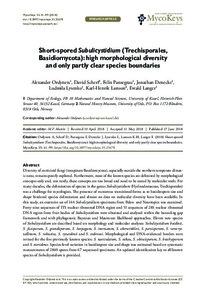| dc.date.accessioned | 2018-08-21T13:08:54Z | |
| dc.date.available | 2018-08-21T13:08:54Z | |
| dc.date.issued | 2018-06-27 | |
| dc.identifier.issn | 1314-4049 | |
| dc.identifier.uri | urn:nbn:de:hebis:34-2018082156266 | |
| dc.identifier.uri | http://hdl.handle.net/123456789/2018082156266 | |
| dc.description.sponsorship | Gefördert durch den Publikationsfonds der Universität Kassel | |
| dc.language.iso | eng | |
| dc.rights | Urheberrechtlich geschützt | |
| dc.rights.uri | https://rightsstatements.org/page/InC/1.0/ | |
| dc.subject | basidiospores | eng |
| dc.subject | biodiversity | eng |
| dc.subject | biometry | eng |
| dc.subject | crystals | eng |
| dc.subject | cystidia | eng |
| dc.subject | DNA barcode | eng |
| dc.subject | encrustation | eng |
| dc.subject | genetic distance | eng |
| dc.subject | internal transcribed spacer | eng |
| dc.subject | large subunit | eng |
| dc.subject | species delimitation | eng |
| dc.subject | taxonomy | eng |
| dc.subject.ddc | 570 | |
| dc.title | Short-spored Subulicystidium (Trechisporales, Basidiomycota): high morphological diversity and only partly clear species boundaries | eng |
| dc.type | Aufsatz | |
| dcterms.abstract | Diversity of corticioid fungi (resupinate Basidiomycota), especially outside the northern temperate climatic zone, remains poorly explored. Furthermore, most of the known species are delimited by morphological concepts only and, not rarely, these concepts are too broad and need to be tested by molecular tools. For many decades, the delimitation of species in the genus Subulicystidium (Hydnodontaceae, Trechisporales) was a challenge for mycologists. The presence of numerous transitional forms as to basidiospore size and shape hindered species delimitation and almost no data on molecular diversity have been available. In this study, an extensive set of 144 Subulicystidium specimens from Paleo- and Neotropics was examined. Forty-nine sequences of ITS nuclear ribosomal DNA region and 51 sequences of 28S nuclear ribosomal DNA region from fruit bodies of Subulicystidium were obtained and analysed within the barcoding gap framework and with phylogenetic Bayesian and Maximum likelihood approaches. Eleven new species of Subulicystidium are described based on morphology and molecular analyses: Subulicystidium boidinii, S. fusisporum, S. grandisporum, S. harpagum, S. inornatum, S. oberwinkleri, S. parvisporum, S. rarocrystallinum, S. robustius, S. ryvardenii and S. tedersooi. Morphological and DNA-evidenced borders were revised for the five previously known species: S. naviculatum, S. nikau, S. obtusisporum, S. brachysporum and S. meridense. Species-level variation in basidiospore size and shape was estimated based on systematic measurements of 2840 spores from 67 sequenced specimens. An updated identification key to all known species of Subulicystidium is provided. | eng |
| dcterms.accessRights | open access | |
| dcterms.bibliographicCitation | In: MycoKeys. - Washington, DC [u.a.] : Pensoft Publishers. - 35:41-99(2018) | |
| dcterms.creator | Ordynets, Alexander | |
| dcterms.creator | Scherf, David | |
| dcterms.creator | Pansegrau, Felix | |
| dcterms.creator | Denecke, Jonathan | |
| dcterms.creator | Lysenko, Ludmila | |
| dcterms.creator | Larsson, Karl-Henrik | |
| dcterms.creator | Langer, Ewald | |
| dc.relation.doi | doi:10.3897/mycokeys.35.25678 | |

